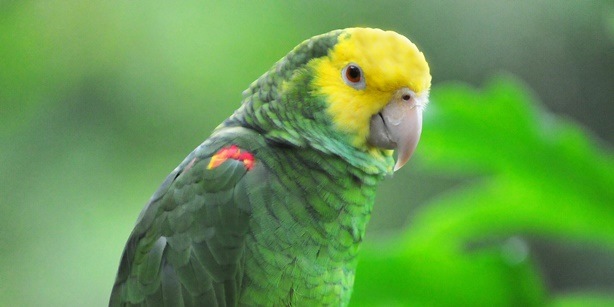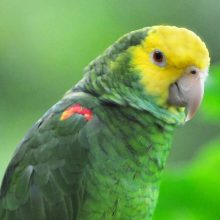Winters are fine, cars are not – wild parrots in Germany
LINKED PAPER
Nest cavity characteristics, reproductive output and population trend of naturalised Amazon parrots in Germany. Martens, J.M. & Woog, F. 2017. Journal of Ornithology. DOI: 10.1007/s10336-017-1436-9. VIEW
Our planet is changing rapidly: Large areas are covered with cities and farmland, the space for wild animals becomes smaller. At the same time, animal species get moved around the world by humans, for example for the pet trade. Sometimes, these introduced species escape and manage to survive in the new area they have been released into.
The city of Stuttgart in south-west Germany has been home to a flock of Amazon parrots (Amazona sp.) since 1984 (Bauer & Woog 2008). It seems to originate from only four founder birds, two Yellow-headed Parrots, A. oratrix, and two Blue-fronted Parrots, A. aestiva (Hoppe 1999), and had grown to over 50 individuals in 2015. The flock now consists of A. oratrix, as well as some A. oratrix x A. aestiva hybrids. The parrots feed on a wide variety of native and exotic plants (Martens & al. 2013).
Yellow-headed Parrots are considered endangered in their native range in Mexico, as only less than 7000 individuals still exist in the wild, due to deforestation and poaching for the pet trade (IUCN 2013). Studying species that manage to survive in a novel habitat and to learn more about which problems and dangers they face can help us to manage threatened species more efficiently.
On the other hand, monitoring introduced species to see how they thrive and spread helps us to protect our native species as well, as they are at risk by competition with introduced species. The Stuttgart Amazon parrots are part of the increasing global phenomenon of urban parrots. At least 11 introduced parrot species live in European cities alone (adapted from DAISIE 2009). It is therefore very important to understand their breeding requirements and how they adapt to urban habitats.
We studied population growth since the first introduction of Amazon parrots in Stuttgart, as well as nest cavity dimensions and locations, reproductive output and causes of mortality. We found that parrot numbers in Stuttgart only increase very slowly. We expected a low reproductive output, possibly caused by the colder temperatures in the novel habitat and a genetic bottleneck due to the low number of founder birds.
We checked 10 accessible parrot nests out of a total of approximately 12 nests in Stuttgart’s public parks with a hydraulic lift twice and observed chick fledging from the ground. All nests were clustered in a small area in the suburb of Bad Cannstatt. They were located in large, old London Plane, Platanus x acerifolia trees and had a narrow entrance, which may be beneficial against predators. All nests were at least 50 cm below the entrance, which may offer protection from the weather and predators.
Surprisingly, we found a rather high number of hatchlings in 2015, and all of them fledged. We found a total of 17 fledglings in 2015, 1.3 fledglings per breeding pair (four with three chicks, one with one chick, five without chicks). 50% of the breeding pairs experienced nest failure. In these cases, the eggs did not hatch. All chicks fledged in July and August. All observed chicks (62%) fledged in the morning. Observations from previous years showed that some juveniles seem to accompany their parrots up to the start of the next breeding season, which is a much longer timespan than initially expected.

Competition with native species seemed to be low, as there are hundreds of seemingly suitable tree hollows in the parks, with a maximum of 12 – 15 parrot breeding pairs. Parrots tolerated smaller bird species (sparrows, starlings, woodpeckers) near their nest. We often observed several species nesting in the same tree as the parrots. Pigeons and other Amazon parrots were usually driven off, as Amazons show territorial behaviour at their nest site.
We collected mortality data from the collection of the Natural History Museum in Stuttgart, as well as animal shelters, council facilities and local citizens. Data on 15 dead and six injured parrots showed that collisions with vehicles (trams, cars) and windows as a main factor. Most birds were found in late summer and autumn, directly after the breeding season, which indicates a high collision risk of newly fledged, inexperienced birds. Predation rates are probably low: Only two reports gave attacks by birds of prey as a cause. Other predators are rare near the nest: Dogs have to be led on a leash and we never observed cats in the parks. At the roost, cats are probably not a risk factor as Amazon parrots usually sleep on very thin twigs that cannot be accessed by heavier mammals.
We conclude that a range expansion of this Amazon parrot is unlikely, as parrot numbers stay low due to a high mortality rate, although reproductive output is high. Furthermore, the survival of these birds in the city, as well as in the native habitat, depends on very large, old trees with suitable hollows for nesting, which in the novel range in Germany can almost exclusively be found in urban parks. We did not find a negative impact by the parrots on the native ecosystem.
References
Bauer, H.G. & Woog, F. 2008. Nichtheimische Vogelarten (Neozoen) in Deutschland. Teil I. Auftreten, Bestaende und Status. Vogelwarte 46: 157–194. VIEW
DAISIE 2009. Handbook of alien species in Europe. Springer, Dordrecht.
Hoppe, D. 1999. Exoten im Park: die Gelbscheitelamazonen von Stuttgart. Falke 46: 142–146.
IUCN 2013. The IUCN Red List of threatened species. https://www.iucnredlist.org. Accessed August 2015.
Martens, J., Hoppe, D. & Woog, F. 2013. Diet and feeding behaviour of naturalised Amazon Parrots in Stuttgart, south-western Germany. Ardea 101: 71–77. VIEW
Image credit
Featured image: Yellow-headed Parrot, Amazona oratrix | Heather Paul | CC BY-ND 2.0
If you want to write about your research in #theBOUblog, then please see here.






